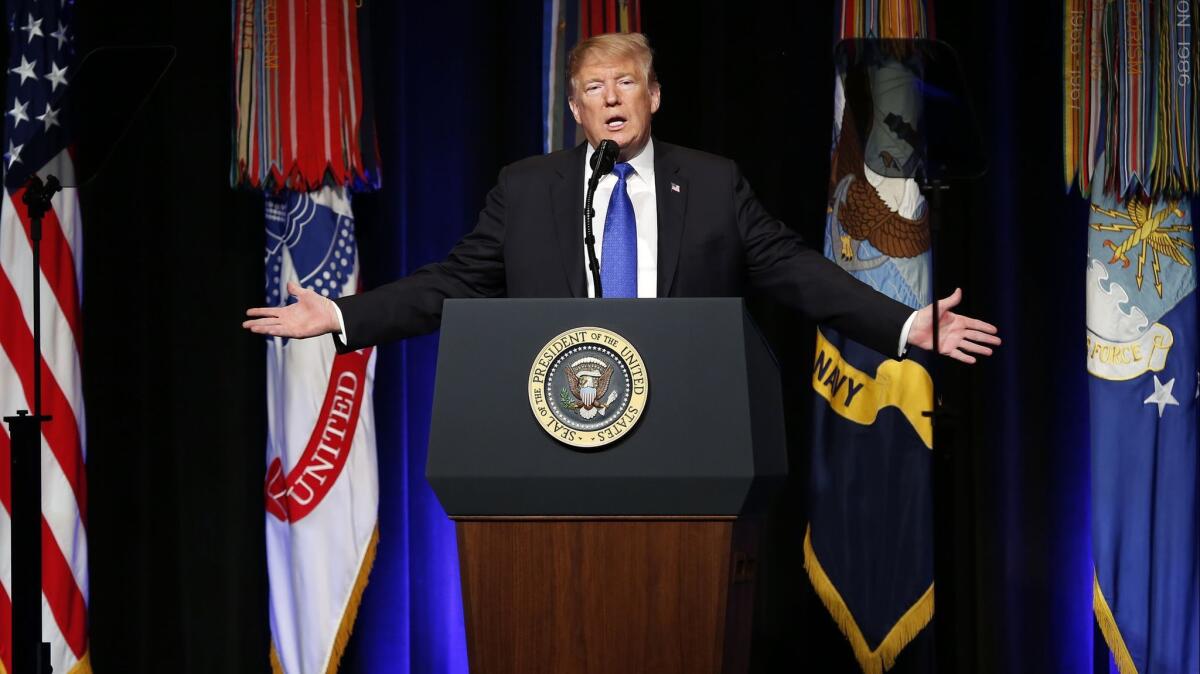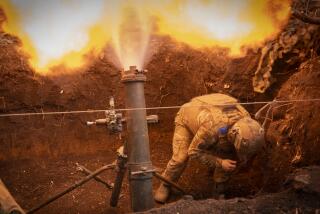A wall in space? Trump envisions an impenetrable missile shield and vows to boost spending

President Trump called Thursday for dramatically broadening U.S. defenses against missile attacks, outlining a costly and scientifically unproven plan for developing lasers and space sensors to defend all of U.S. territory from ballistic missile threats.
“Our strategy is grounded in one overriding objective: to detect and destroy every type of missile attack against any American target, whether before or after launch,” Trump said at the Pentagon as the administration released its long-awaited missile defense strategy.
Trump’s expansive vision of an impenetrable U.S missile shield — one first envisaged by President Reagan 35 years ago — goes well beyond the Pentagon’s technical and scientific capacity, the reality that grounded most of Reagan’s “Star Wars” initiative.
The plan also does not reflect the Trump administration’s near-term goals, which remain focused on developing the capability to knock out limited missile strikes by Iran or North Korea and, at least theoretically, new short- and medium-range weapons being developed by China and Russia that could threaten Europe and Asia.
But Trump used the speech to press his “America First” agenda, fitting his call for expanded missile defense in with familiar broadsides on Democrats in Congress for blocking his proposed border wall and on U.S. allies for failing to pay enough for their own defense.
When Trump attacked House Speaker Nancy Pelosi (D-San Francisco) for opposing the border wall and said Democrats had been “hijacked” by the “fringe” and “radical left,” the audience of uniformed military officers and Defense Department officials sat silent.
Democrats in Congress, even some who have backed the development of the current limited U.S. missile defense system, questioned Trump’s vision of a vast shield over the nation.
“An effective missile defense system can serve as a deterrent to conflict, protect our forward-deployed forces and the homeland, and create an opening for diplomacy,” said Sen. Jack Reed (D-R.I.), a member of the Armed Services Committee. “But it’s not a magic bulletproof shield, and it comes with a considerable price tag.”
Joseph Cirincione, a nuclear weapons expert at Ploughshares Fund, a Washington-based anti-nuclear-proliferation organization, called the Trump plan “a grab bag of contractor proposals to build space weapons we don’t need, don’t work and can’t afford.”
The 81-page Missile Defense Review, released by the Pentagon as Trump began speaking, cites Russian and Chinese medium-range missiles as possible targets of anti-missile defenses.
That’s a departure from previous administrations, which insisted the U.S. system was aimed at so-called rogue states and at intercepting accidental launches but was too small to be of concern to major powers with intercontinental missiles and large nuclear arsenals.
Acting Defense Secretary Patrick Shanahan said the U.S. was considering measures for the first time to guard against Russian and Chinese medium-range missiles, including hypersonic weapons that travel far faster than sound and could threaten U.S. forces abroad and allies in Europe and Asia.
China and Russia “are expanding their missile arsenals … and [integrating] these more effectively into war planning,” Shanahan said in remarks before Trump spoke, adding that Iran and North Korea’s missiles “remain a significant concern.”
The Pentagon has built a growing capability to target medium-range weapons with advanced radars and interceptors from Aegis-class warships in the western Pacific and eastern Mediterranean. A U.S. medium-range interceptor site is also operational in Romania while another is under construction in Poland.
U.S. officials say those defenses are aimed at Iran and North Korea.
Russia has complained for years that the U.S. system could in theory target its missiles and have vowed to respond if the U.S. goes ahead with the two sites in Eastern Europe. That stance is likely to harden with the U.S. now explicitly vowing to develop a system capable of targeting Moscow’s missiles.
Shanahan acknowledged that the expanding U.S. defenses were a major factor driving Russia and China to build faster and more survivable missiles.
Russia, in particular, has developed a new SSC-8 ground-fired cruise missile that U.S. officials say violates the Intermediate-Range Nuclear Forces Treaty and could give Moscow the ability to launch a nuclear strike in Europe with little or no notice. The Trump administration has threatened to pull out of the INF treaty as a result.
“Frustrated by our mid-course defenses, they are aggressively pursuing new technologies to circumvent today’s systems,” Shanahan said.
For his part, Trump failed to mention Russia or North Korea. He has frequently praised Russian President Vladimir Putin since taking office and is seeking a second summit with North Korean leader Kim Jong Un.
North Korea tested a suspected hydrogen bomb and a long-range ballistic missile capable of reaching the United States after Trump took office, but after meeting with Kim at a summit last June in Singapore, Trump declared that Pyongyang no longer represented a nuclear threat to America.
Experts say, however, they’ve seen no sign that Kim’s regime has taken any steps to give up its nuclear weapons arsenal or production. Several North Korean officials were due in Washington on Friday to discuss a second summit and, apparently, to try to revive the stalled talks.
The missile defense review calls for researching the feasibility of developing and launching sensors in space that could detect missile launches around the globe. It also calls for further research into lasers and other so-called directed-energy weapons that could, in theory, knock out ballistic missiles early in flight.
The Pentagon is supposed to deliver a report within six months on placing non-nuclear missile defense interceptors on satellites.
The administration plans to add more interceptors to the existing missile defense sites at Ft. Greely in Alaska and at Vandenberg Air Force Base near Lompoc. The report calls for studying the option of adding a third interceptor site on the East Coast, an idea aimed at bolstering defenses against a possible limited missile attack from Iran.
Even an expanded missile shield would not be capable of stopping a major attack by Russia or China, U.S. officials said.
Both countries have large arsenals of intercontinental ballistic missiles topped with nuclear warheads that U.S. officials say could overwhelm an expanded U.S. system in a large-scale nuclear exchange.
U.S. strategy relies on deterrence and the threat that it would respond to any nuclear attack with a devastating nuclear counterattack. Expanding defenses could prompt Russia and China to invest in new weapons systems, spurring a new arms race, critics warned.
The new strategy is “likely to exacerbate Russian and Chinese concerns about the threat to their strategic nuclear deterrents, undermine strategic stability, and further complicate the prospects for additional nuclear arms reductions,” the Arms Control Assn., a nonpartisan Washington policy organization, said in a statement.
Twitter: @davidcloudLAT
More to Read
Start your day right
Sign up for Essential California for news, features and recommendations from the L.A. Times and beyond in your inbox six days a week.
You may occasionally receive promotional content from the Los Angeles Times.







